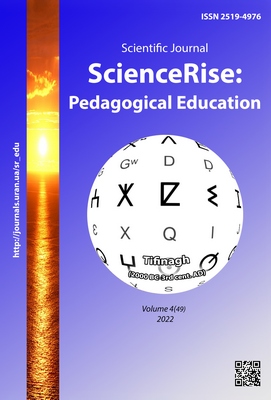English and French vocabulary as a product of historical development
DOI:
https://doi.org/10.15587/2519-4984.2022.261748Keywords:
word-stock, assimilated, borrowings, recipient language, loan word, lexicographic data, penetration, vice versa, withness the influence, AnglicismAbstract
The word-stock of any language may be subdivided into the sets. The elements of one are native, the elements of another are borrowed. Borrowings are modified in phonetic shape, spelling or meaning according to the standards of the recipient language. The process of interpenetration is constantly going on. One penetrated into a certain language system, a loan word is assimilated and undergoes semantic changes. The greater are the changes, the weaker is the connection of the word with its traditional use in the original language. According to the latest lexicographic data we can speak of a formation tendency of new lexical equivalents in Indo-European languages and the necessity to study them. The French language, which is the object of the study of language, consists of several varieties. The vocabulary of the language is constantly changing, to a greater or lesser extent. Changes are tracked and recorded, which allows to adequately understand modern language, which is developing as a living thing. Social changes of time, caused by changes in the structure of the socio-political system, changes in ownership and composition of active participants in communication, cause a conscious change in language norms. This is expressed primarily in the growth of variant elements of communication, a large number of new loanwords and terms, and, finally, in stylistic changes in the meaning of oral and written language, with a marked change in the domestic sphere of communication. The problem, investigated in the article, is connected with the history of penetration of foreign words, among them English, into the French language and vice versa. Everybody can withness the influence of English borrowings in one foreign language nowadays, the process of adaptation of Anglicisms. The aim of the paper is to confirm loanwords in the French language that are a result of lexical interference of two languages – two cultures – in contact. The material of the investigation is about 70 per cent of Anglicisms, picked out from the latest mass media publications in French. The scientific novelty of the research consists in the fact that Anglicisms make up a part of the French word-stock, replenish the language vocabulary
References
- Davies, N., Jones, D. et. al. (1990). A Common Wealth: Life and Culture in the English-speaking World. Solna: Liber Hermods och Utbildningsradion, 22–25, 106–130.
- Verba, L. H. (2004). Istoriia anhliiskoi movy. Vinnytsia: Nova knyha, 304.
- The Cambridge History of the English Language Cambridge: Vols. 1–6 (2005–2008). Cambridge: Cambridge University Press.
- New Webster’s Dictionary of the English language (1988). Surjeet Publications.
- Hogg, R., Denison, D. (2006). A History of the English Language. Cambridge: Cambridge University Press, 495.
- Romanistychni doslidzhennia: Suchasnyi stan ta perspektyvy (do 100-richchia romanistyky u Lvivskomu universyteti) (1997). Lviv.
- Selihei, P. O. (2017). Z istorii puryzmu v anhliiskii literaturnii movi. I. Movoznavstvo, 5, 3‒18.
- Soloshenko, O. D., Zavhorodniev, Yu. A. (1998). Konspekt lektsii z leksykolohii anhliiskoi movy. Lviv.
- Baugh, A. C., Cable, Th. (2002). A History of the English Language. London: Routledge, 447.
- Bragg, M. (2011). The Adventure of English: The Biography of a Language. New York: Arcade Publishing, 322.
Downloads
Published
How to Cite
Issue
Section
License
Copyright (c) 2022 Nataliia Bandrivska

This work is licensed under a Creative Commons Attribution 4.0 International License.
Our journal abides by the Creative Commons CC BY copyright rights and permissions for open access journals.
Authors, who are published in this journal, agree to the following conditions:
1. The authors reserve the right to authorship of the work and pass the first publication right of this work to the journal under the terms of a Creative Commons CC BY, which allows others to freely distribute the published research with the obligatory reference to the authors of the original work and the first publication of the work in this journal.
2. The authors have the right to conclude separate supplement agreements that relate to non-exclusive work distribution in the form in which it has been published by the journal (for example, to upload the work to the online storage of the journal or publish it as part of a monograph), provided that the reference to the first publication of the work in this journal is included.








